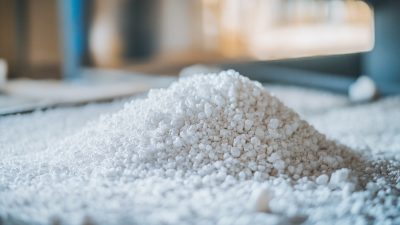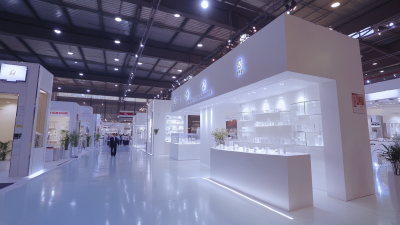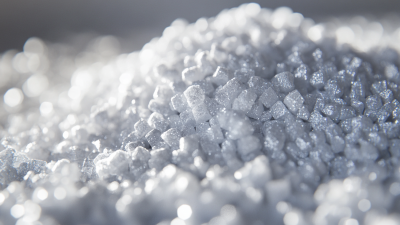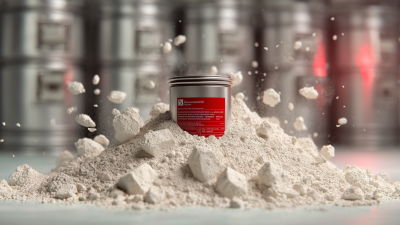In recent years, Tabular Alumina has emerged as a critical material in various industrial applications, fundamentally transforming sectors from metallurgical to chemical processing. According to a report by Grand View Research, the global alumina market size was valued at USD 119.12 billion in 2021 and is expected to expand at a compound annual growth rate (CAGR) of 5.3% from 2022 to 2030. This growth is fueled by the increasing demand for high-performance materials capable of withstanding extreme conditions, with Tabular Alumina being at the forefront due to its exceptional thermal stability and mechanical strength.
Notably, Tabular Alumina, a high-purity alumina product achieved by the calcination of bauxite, offers unparalleled advantages for specific applications. The North American and Asia-Pacific regions are recognized as leading markets, driven by robust industrial activities and technological advancements in manufacturing processes. Furthermore, data from industry analysts highlight that the refractory segment accounts for a significant share of Tabular Alumina consumption, emphasizing its vital role in applications requiring advanced thermal and chemical resistance. As we explore the top five applications of Tabular Alumina in 2025, it becomes evident that understanding its unique properties and market dynamics is essential for leveraging its full potential in industry advancements.

Tabular alumina, known for its exceptional thermal stability and mechanical strength, is rapidly gaining traction in high-temperature insulation applications. Its ability to withstand extreme conditions makes it an ideal material for industries such as aerospace, metallurgy, and ceramics. The use of tabular alumina in lightweight and efficient insulation solutions allows manufacturers to enhance energy efficiency while minimizing heat loss. As industries increasingly focus on sustainability, the demand for high-performance insulating materials like tabular alumina is expected to rise.
Furthermore, advancements in production technologies have made tabular alumina more accessible for various applications. The growth of the specialty alumina market reflects the growing recognition of tabular alumina's role in enhancing product performance. As the market evolves, innovative applications are emerging, particularly in high-temperature settings where conventional insulators may fail. This shift towards tabular alumina signifies a broader trend of prioritizing durable, high-efficiency materials in modern manufacturing processes, paving the way for a more resilient industrial landscape.
 Tabular alumina is increasingly recognized for its superior properties in refractory applications, offering significant advantages over traditional materials. One of the key benefits is its exceptional high-temperature stability. According to a report by the Refractories Institute, tabular alumina can withstand temperatures exceeding 1750°C, making it ideal for use in steel, cement, and foundry industries where high thermal stability is paramount.
Tabular alumina is increasingly recognized for its superior properties in refractory applications, offering significant advantages over traditional materials. One of the key benefits is its exceptional high-temperature stability. According to a report by the Refractories Institute, tabular alumina can withstand temperatures exceeding 1750°C, making it ideal for use in steel, cement, and foundry industries where high thermal stability is paramount.
Additionally, tabular alumina exhibits excellent thermal shock resistance and mechanical strength. The structural integrity it maintains under rapid temperature changes minimizes the risk of failure in extreme environments. A study published in the Journal of the American Ceramic Society highlighted that refractory products utilizing tabular alumina demonstrated a 30% improvement in thermal shock resistance compared to those made from conventional alumina. This enhanced durability contributes to longer service life and reduced maintenance costs for equipment, which is a critical concern for industrial operations.
Furthermore, the low porosity of tabular alumina not only improves the overall performance of refractory materials but also reduces the absorption of slag and other contaminants. According to a market analysis by Research and Markets, this quality aligns with the industry's ongoing shift toward more efficient and sustainable manufacturing practices, positioning tabular alumina as a frontrunner in refractory technology for the future.
Tabular alumina, with its unique properties of high purity and excellent thermal stability, is revolutionizing the steel manufacturing process. According to a recent industry report by MarketsandMarkets, the global market for tabular alumina is projected to reach USD 926 million by 2025, highlighting its growing significance in various applications, particularly in steel production. By serving as a high-performance refractory material, tabular alumina enhances the efficiency of electric arc furnaces, crucial for steelmaking.
In addition to its role in refractories, tabular alumina is increasingly utilized in the production of ceramic molds and cores for casting applications. The 2023 Ceramic Industry Report emphasizes that using tabular alumina in the mold-making process can reduce defects and improve dimensional accuracy, thus contributing directly to better-quality steel products. Furthermore, the material's impressive abrasion resistance makes it ideal for lining ladles and tundishes, minimizing wear and extending equipment life. As steel manufacturers continue to seek innovative solutions to boost productivity while maintaining high standards, tabular alumina stands out as a key material driving advancements in the industry.
Tabular alumina, a high-purity form of alumina, plays a pivotal role in the development of advanced ceramic composites. Its unique properties, including exceptional thermal stability, mechanical strength, and low thermal expansion, make it an invaluable material in various industrial applications. According to a report from the Global Ceramic Composites Market (2022), the demand for ceramic composites is projected to grow at a CAGR of 7.5% from 2022 to 2028, markedly increasing the importance of high-performance materials like tabular alumina.
In the realm of advanced ceramics, tabular alumina is integral to enhancing the mechanical properties of composite materials. With a specific surface area of only 1-2 m²/g and a particle size range of 100-200 µm, its structure allows for better densification and performance in high-temperature environments. A study by the American Ceramic Society highlighted that incorporating tabular alumina can enhance the flexural strength of alumina-based composites by up to 30%. This property is particularly beneficial in industries such as aerospace and automotive, where material integrity under extreme conditions is critical.
Moreover, tabular alumina serves as a crucial filler in ceramic matrix composites, contributing to improved wear resistance and thermal shock resistance. The market analysis indicates that sectors utilizing advanced ceramic composites, including electronics and energy, are increasingly seeking materials that provide durability and stability. This trend underscores the growing significance of tabular alumina in the advancement of modern ceramic technologies.
Tabular alumina, a high-purity aluminum oxide, plays a crucial role in enhancing the efficiency and longevity of catalytic converters in the automotive industry. Its unique properties, including high thermal stability, low thermal conductivity, and excellent mechanical strength, make it an ideal choice for manufacturers seeking to improve the performance of their emissions control systems. By serving as a support material for catalysts, tabular alumina helps to distribute the active catalytic components evenly, promoting more effective chemical reactions that convert harmful gases into less toxic emissions.
Moreover, the use of tabular alumina in catalytic converter applications leads to a reduction in the overall weight of the system, which is vital in today’s automotive market focused on fuel efficiency. Its ability to withstand extreme temperatures and corrosive environments ensures that the catalytic converters maintain their effectiveness over prolonged periods, thereby extending the lifespan of the vehicle's emissions systems. As automakers increasingly prioritize compliance with stringent environmental regulations, the integration of tabular alumina into catalytic converters is set to become a standard practice, reinforcing its significance in the evolution of cleaner automotive technologies.







